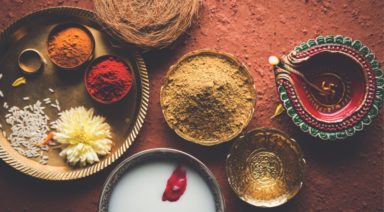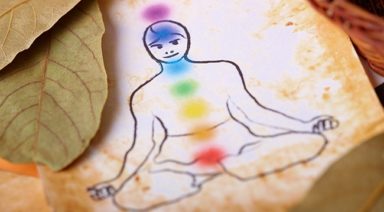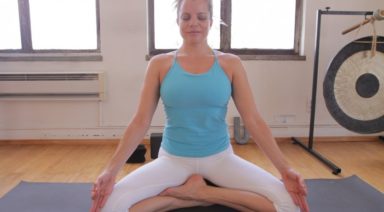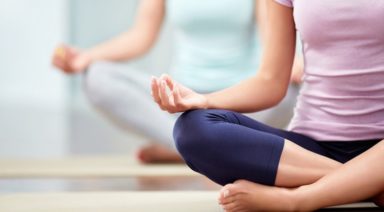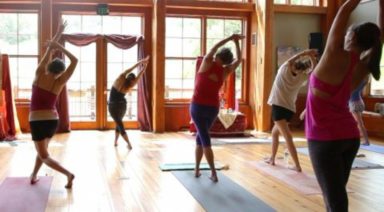10 Ways Yoga Practice Can Lessen Your Holiday Stress
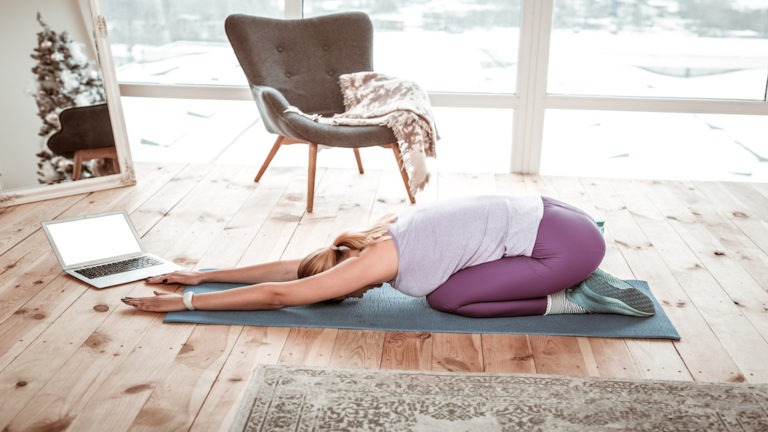
There is no better time to take your yoga practice “off the mat and into your life” than over the holidays! Whether you are a new student of yoga asana (movement) or a seasoned yogi, here’s a handy guide for using all the tools at your disposal–including breath, movement, and mindfulness–to limit stress and maximize happiness in the coming months:
1. Stay healthy.
Chronic health issues often flare up over the holidays, so don’t forget to use your yoga practice as preventive medicine. Keep persistent symptoms at bay with a daily dose of yoga. Drain your lymphatic system and increase blood circulation through postures and movement.
Try combating infections and colds by opening up your chest with a gentle fish, bridge, or bow pose. Don’t skimp on your yoga just because you are busy! Everyone has time for a quick round of sun salutations in the morning, a few standing forward bends at lunch, or some breathing techniques before bed–no mat or props needed. Remember the old saying: An ounce of prevention is worth a pound of cure. Were they talking about yoga?
2. Be worry-free
“I’m so stressed out. My mind is racing. Everything seems overwhelming. I just can’t stop thinking!” Are anxious feelings wearing down your holiday spirit? Politely excuse yourself from the party; turn off the computer – just take a break. Find a quiet, peaceful spot for some yogic mantra or meditation. You can quickly detach from worrisome thoughts by focusing on the individual sounds of the mantra or by simply following the breath – in and out.
Sometimes a longer exhalation or pausing at the end of your out-breath can calm a speedy mind. If time permits, do some asanas – child’s pose to really let go, balancing poses (like tree pose) to connect to earth and sky, or toe squat to stretch your feet and take the focus out of your mind and into your body. A restorative yoga session can be an hour well spent; your worries will literally melt into the mat and leave you feeling clear and refreshed.
3. Increase your concentration.
As if your life isn’t hectic enough, add in holidays with extended family, shopping, school recitals, the annual office party; the list goes on! All these distractions can wreak havoc on our memory, concentration, and problem-solving. In order to stay productive, incorporate asanas that increase mental focus–like warrior I, II, III, dancer’s pose, eagle pose, or shoulder stand–into your practice. Activate your tired brain with a series of breathing exercises. You can do them anywhere, anytime, seated or standing.
Really crunched for time? Take a few moments sitting in a comfortable seat (eyes closed or with an unfocused gaze), or stand in mountain pose with your hands in anjali mudra (palms together in front of your chest). The simple act of remaining still with palms pressed together can help bring you back to your center.
4. Keep your body toned and fit.
Maybe you’ve done one yoga class, maybe one thousand. No matter your strength, flexibility, muscle tone, core stabilization, balance, cardio health, enhanced athletic performance–the benefits of yoga become apparent with that very first stretch or twist. You might have a consistent practice when November rolls around. Suddenly there’s no time to cook dinner, let alone squeeze in an entire yoga series.
What to do? Do something rather than nothing! Try adding a few minutes of yoga before or after a workout, run or walk. Strike a few powerful poses before the kids get up in the morning, or discretely activate your core with tummy toning exercises while sitting on the couch. During the holiday season, concentrate on the target areas most important to you, and the rest can wait. If you need shoulders flexibility, keep up your downward dogs; if your spine is an issue, don’t skimp on back-bends, forward bends, and twists; if tricep strength is what you’re after, practice chaturangas as often as you can during your yoga flow.
5. Keep your weight stable
Everyone knows a good yoga series burns calories, builds muscle, and provides your body with a systematic, holistic workout. More importantly, yoga practice helps you make friends with your body. This is no small statement. When you know your body, you eat more consciously, recognizing the difference between a food craving and actual hunger. You make more sensible food choices, and intuitively eat less because you know when you are actually full.
Over the holidays, even our most thoughtful meal planning can be disrupted, it’s hard to say no to grandma’s pumpkin pie, or your cousin might be eyeing your dinner plate to see if you’ve eaten all his homemade mashed potatoes. Try keeping your “yogi mind” at family dinners. Stay centered, drink plenty of water, and don’t forget to breathe deeply when you feel stressed or overwhelmed. You can also practice cardio yoga styles during the holidays– power vinyasa, warm or hot flow, sculpt with weights–to get maximum aerobic benefits in the shortest amount of time.
6. Lift your mood and maintain a positive outlook.
Yoga practice is a great way to boost sagging spirits and tame your depression. Yoga raises your heart rate and gets the blood flowing throughout the body.
If you are feeling blue, try stretching your arms overhead and spreading your toes wide in a simple raised arm mountain pose. Backbend in bridge or cobra, opening your chest, rib-cage, and heart. Any inversion that gets your head lower than your heart–supported headstand, legs-up-the-wall pose, shoulder stand, or handstand–can have a positive effect on mood. If the holidays have really got you down, remember to take care of yourself.
Relax and rejuvenate in your favorite restorative pose; don’t skimp on any blankets or props needed for extra comfort. For mental stimulation, use a breathing exercise like bellow’s breath to stir your prana – it’s better than a cup of coffee! Let your yoga practice serve as a physical reminder that your mood won’t stay low forever. Change happens all by itself if you stay on your mat, breath, and follow the sequence of poses.
7. Sleep more
Work is stressful and your parents are coming for an extended holiday stay. You’re worried and anxious so it’s hard to fall asleep. You toss and turn all night, and now you’re cranky and irritated at breakfast. The sleep deprivation cycle begins and with it all the troubling symptoms; insomnia, exhaustion, overstimulated nervous system, chronic stress, sensory overload, muscle tightening, tension headaches, and more.
How can yoga help? Get in a rigorous session during the day, so your body is tired by nightfall, or try a gentle yoga series before bed. Deep exhalations allow your nervous system to relax and your breathing to slow down. Use poses that relieve physical tension such as spinal twists (seated or supine), plow, or a gentle forward fold (let your head hang). Turn out the lights, turn off the day. Climb into bed and let it all go with a final savasana.
8. Improve your vitality and energy
What happens when you follow a sequence of yoga movements choreographed to the rhythm of your breath? Your blood flow increases, more oxygen gets delivered to your cells and tissues, red blood cell and hemoglobin counts rise. You feel rejuvenated. What about when you’re tired? A series of sun salutations can warm and stimulate both the body and the mind. Chair and eagle are also energizing poses you can do anytime; hold them longer to generate more heat and internal energy.
Be sure to make an extra effort to keep your yoga practice going over the holidays; you’ll be rewarded with more vibrancy and stamina to enjoy the whole winter season. Did you overindulge in turkey, stuffing or green bean casserole at Thanksgiving dinner? You’re not alone. Intestinal symptoms like indigestion, acid reflux, bloating and constipation can sap your energy. Wind removing pose (wide leg, legs together, or one leg at a time to target different segments of your colon), twisting poses (to massage your abdomen), reclining bound angle pose (for all your abdominal organs), or some gentle cat-cow movements can offer instant relief for intestinal distress.
9. Maintain your mind-body connection
First, you cut your thumb chopping walnuts for the holiday cookies. Then you trip in your new high heels, twisting your ankle, and minutes later you spill wine on the carpet. Why are we so clumsy and accident-prone during the holiday season? Blame it on the stress- feeling overwhelmed can make you move too fast, lose your mind-body connection, and react with a fight-or-flight response to ordinary situations.
After bandaging your thumb, soaking your ankle, and cleaning the wine stain, cut the cycle of mindlessness- come back to your yoga! Try breathing exercises, balancing poses, or seated meditation. The mindfulness coupled with the physical embodiment your yoga brings can help you recover faster, protect you from further injury, improve your coordination and reaction time, and help you balance better (especially in those heels).
10. Be centered, present, and in the moment
Your commitment to yoga practice is the most precious gift you can give to yourself. Don’t hesitate to use all of your yoga tools– breath, movement, and mindfulness– to keep your holiday season stress-free. Enjoy. Appreciate. Celebrate. Mourn. Rejoice. Connect. Forgive. Extend. Radiate. When you are centered, present, and in the moment, you can give and receive, love and be loved, touch and be touched back. Happy Holidays and Happy Yoga.
Kemetic Yoga: Resurrection of an African Legacy

The geometric positions and postures seen in the hieroglyphs and temple walls of ancient Egypt are some of the earliest manifestations of yoga. Discover how practicing Kemetic yoga poses can profoundly affect your health, wellbeing and consciousness.
As a boy growing up in the public housing projects on the Southside of Chicago, I was always fascinated by ancient stories of mythology, fantasy and warriors. I watched many programs about the wonders of the ancient world on public television. The most fascinating aspect of the ancient world for me had always been the mysteries of Egypt. From the first time I’d seen the pyramids and the Sphinx in documentaries, movies and in books I wanted to travel there and see them in person.
The Great Black Kings of Africa
At Catholic grade school in the 1960s, my one and only Black male teacher, Mr. Rochelle, introduced his class to books by the Black historians, including J.A. Rogers, who wrote Great Black Men of Color. This book spoke of the Great Black Kings of Africa and their accomplishments. It also revealed to us that Egypt is in Africa, is the origin of western civilization and that the Pharaohs of ancient Egypt were actually Black.
This information became even more interesting to me when I saw that in my grade school geography book that the country of Egypt (northeastern Africa) was absent from the map of Africa. The space where Egypt is supposed to be was blank.
The country of Egypt was instead placed in a separate circle in the upper corner of the page with the words “middle east” written under it.
What I learned in later years is that there has been a concerted effort on the part of western academia to take Egypt out of the context of Africa and to place it in the European/Middle Eastern area of civilization.
Mount Meru: The Origin of Humanity
DNA studies show conclusively that the original modern human beings emerged out of Africa over 3.5 million years ago. The people of India, who were originally an all-Black people called Dravidians, had DNA that originated in Ethiopia. Ethiopia is part of the African region called “Kush” that included ancient Egypt, Sudan and Ethiopia, all of which comprises a large chunk of Africa. In the book “Opening to Spirit”, author and Yoga master, Shola Arewa draws the connection between ancient Indian stories of the origin of humans on Mount Meru, with East Africa, where the actual mountain of Meru stands at over 15,000 feet in the shadow of Mount Kilimanjaro.
Hatha and HetHeru There are many similarities between words in Sanskrit and the ancient Egyptian language as it relates to Yoga. For example, the word Hatha which designates the general system of Yoga and means “Moon” and “Sun”, similar to the ancient Egyptian word “Hathor”, which was originally pronounced “Het Heru” by the ancient Egyptians. Hathor or Het Heru is the goddess of the moon and sun.
In ancient Egypt she was personified by a cow. Interestingly the cow is held sacred in Indian culture and is never killed. The Indian cow goddess Kamadhenu, like HetHeru, represents the sacred mother and fertility.
At the age of 21, I made a conscious decision to completely leave the bad habits I had acquired growing up in the ghettoes of Chicago behind me. I stopped all drinking, smoking and the use of psychedelic drugs. As a child of the 60s I had learned to use drugs like marijuana and acid as a means of creating a transcendent consciousness. I also realized that even though these substances could be used to explore the mind that they often had negative impact on my health and wellbeing. Therefore, I decided that I would take up a vegan diet and use fasting, meditation and exercise (running and calisthenics) as my new path towards higher consciousness.
My Yogic Journey
About a year after embarking on this new path, I met someone who was into Yoga. After a great deal of hesitancy, I allowed myself to try out a Yoga class. After the first class with my one and only teacher, Dr. Asar Hapi of Chicago, a Black man, Naprapath and Chiropractor, I knew that I would make Yoga my life long path.
Though I was very stiff at the beginning, I could feel the benefits; I felt relaxed and my energy improved. I learned that physical benefits of Yoga, such as flexibility, came as a consequence of practice. My teacher, Dr. Hapi, had already adopted an ancient Egyptian name. We both felt that Yoga probably came from Egypt but we did not have any particular proof.
Revelations From King Tut’s Tomb
This changed when the King Tut exhibit came to Chicago in the mid-1970s. One of the artifacts that were found in the tomb of King Tut was a chair that contained a uniquely ancient Egyptian Yoga posture and various hieroglyphic inscriptions.
We were inspired to figure out how to perform this posture, translate the hieroglyphic writing and interpret the symbols. Our investigation of the artifact revealed the following:
- The Sun Disk at the top of the head represents the crown chakra
- The two serpents on each side of the sun disk represents the two primary nadis (energy channels) Ida and Pingala
- The hieroglyphic inscriptions make reference to eternity and the achievement of immortality
- The “person” or deity pictured in posture is called Heh or Shu and is associated with life energy, the breath and the life force found in the air (prana)
- He is seated on a platform that means “Nub” which is the ancient Egyptian word for gold. Gold is a metaphor for the highest level of consciousness that a person can reach which is the ultimate purpose of the practice of Yoga
Resurrection of Ancient Egyptian Yoga
As we explored more of the ancient Egyptian records through books it became apparent that Gods and Goddesses they called “Neteru” were actually in various Yoga postures that did not exist in the Indian system. The philosophies of Yoga, Hinduism, Buddhism and Taoism were similar and in some cases identical to ancient Egyptian spiritual science. They are various examples of this:
Maat
The ancient Egyptian philosophical idea that the underlying nature of the universe is predicated on a discernable order that each individual person is obligated to strive for. According to Maat the true nature of everything is order, balance, harmony, justice and reciprocity. This principle of Maat and these attributes need to be exemplified in the way that we live our lives in order to transcend the limitation in consciousness that comes with identification with the temporal world of cause and effect. It is the over identification with the physical body and material world that gives rise to all of the problems that afflict humankind.
A woman sitting on one folded leg with spine twisted and arms extended personifies Maat. The arms have wings attached which signify the ability to heal and for the spirit to take flight or rise metaphorically. Maat wears a feather on her head.
In the ancient Egyptian funeral rites, the heart of the of the deceased person Wwas symbolically weighed: it had to be lighter than the feather in order for the person to achieve immortality.
Hermetic Philosophy
The Greeks called him Hermes but the ancient Egyptians called him Tehuti or Thoth. Thoth was the great spiritual teacher of ancient Egypt who was the inventor of writing, knowledge and wisdom. Hermetic philosophy speaks of methods of achieving immortality through the practice of techniques that allows the mind to disassociate with identification with the material world. This idea of disassociation and transcendence was referenced in all of the earliest Yogic writings from India. This process depended upon the practice of contemplation and meditation rather than the performance of hundreds or even thousands of Yoga postures that characterizes modern Yoga. Thoth delineated 7 primary principles that became the foundation of what was later to be called Hermetic philosophy and gave rise to Free Masonry, Theosophy and many other modern “new age” philosophical movements.
The Seven Principles of Hermetic Philosophy
The seven principles are:
- The Principle of Mentalism: The All if Mind and the Universe is Mental
- The Principle of Correspondence: As above, so below, as below so above
- The Principle of Vibration: Nothing Rests, everything moves, everything vibrates
- The Principle of Polarity: Everything is dual, everything has poles, everything has its pair of opposites, like and unlike are the same, opposites are identical in nature, but are different in degree, extremes meet, all truths are but half-truths, all paradoxes may be reconciled.
- The Principle of Gender: Gender is in everything, everything has its masculine and feminine principles, gender manifests on all planes
- The Principle of Rhythm: Everything flows out and in, everything has its tide, all things rise and fall, the pendulum swing manifests in everything, the measure of the swing to the right is measure of the swing to the left, rhythm compensates
- The Principle of Cause and Effect: Every cause has an effect, every effect has a cause, everything happens according to law and chance is but a name for law not recognized, there are many planes of causation but nothing escapes the law
For those who are familiar with the philosophy of Yoga, the similarities with Maat and what is called Hermetic philosophy are intuitive.
Key Difference
However, there are key differences in the approaches of Yoga as it was understood and practiced in ancient Egypt and India. A fundamental aspect of ancient Egyptian spiritual science (which is identical across Africa) is the connection to ancestors. In ancient Egypt, which is properly called Kemet (Egypt is the Greek version of the word), connecting with the spirits of the ancestors through meditation, prayer and ritual is a pillar of Kemetic Yoga practice. The purpose of meditation is not only to transcend the boundaries of the material world but also to connect and communicate with the living spirits of those who have gone before us.
About two years after I started my practice of Yoga with Dr. Hapi, he informed me that he was going to focus his attention on his healing practice and that I should continue to develop and teach the system of ancient Egyptian Yoga. Though I really only wanted to practice Yoga for my own development, I eventually started to teach it more regularly. I decided to use the term Kemetic Yoga because it is the correct Egyptian term. Over the years I have done more original research into the philosophy and practice of Kemetic Yoga through traveling to Egypt, studying ancient texts, deciphering symbols and introducing new movements and postures into the system.
Kemetic Yoga Poses
We perform many of the movements and posture or asanas that are found in mainstream Hatha Yoga because many are seen in the record of ancient Egypt and are also represented among the practices of traditional African societies. Some of the postures and movements that are uniquely ancient Egyptian are:
- The Pose of Immortality
- The Pose of Auset/Maat
- The Pose of Min/Sekhmet
- The Teken Pose/Teken Sequence
- The Sesh Poses
- The Pose of Anpu (Peaceful Warrior Pose)
- The Maat Ka Sequence
- The Pose of Selkhet
- The Pose of Ausar
- The Pose of Geb
The YogaSkills Method
I have synthesized the practice of Kemetic Yoga into a system called the YogaSkills Method. YSM is based upon two concepts called Rule of Four Breathing (RFB) and Geometric Progression. RFB simply means that each breath should be mindfully divided into four parts: Inhalation, Pause, Exhalation, Pause. This is simply to allow the mind to stay focused and so that energy can move properly through the body. GP or Geometric Progression means that we are moving the body through postures in a manner that is consistent with physical and spiritual anatomy and that allows energy to flow through the channels (nadis).











